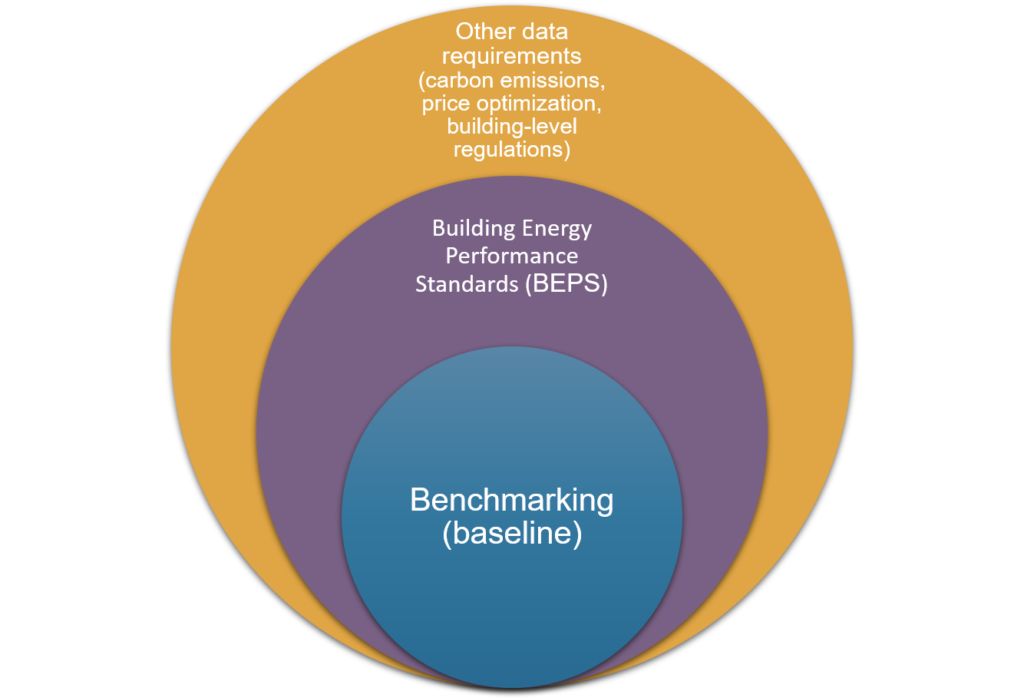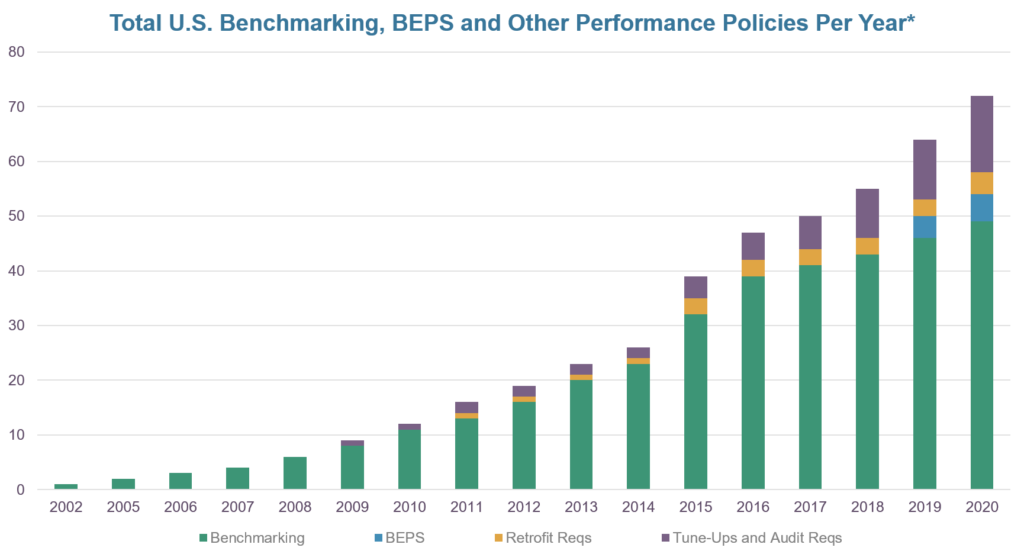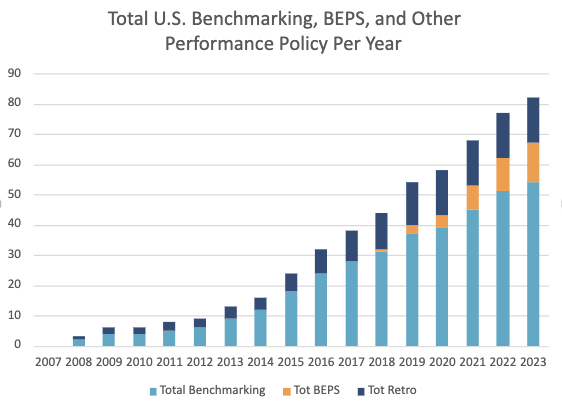What’s Your Baseline? Benchmarking and the Advancement of Building Performance Standards (BEPS)
This blog is an update to Calico’s original blog post titled “What’s Your Baseline? Benchmarking and the Advent of Building Performance Standards (BEPS)” from August of 2020. We have woven our 2023 update in italics along with our original 2020 text.
Then: If you’re in the utility world, or the energy policy world, or the building management world (or, or, OR), you know about building benchmarking. Typically when required, owners measure and submit their building’s energy consumption for comparison and analyses, most often by the EPA. For a while, these policies proliferated across the nation, providing low-cost, low-risk resource conservation and climate change mitigation.1 Recently, policies have seemingly slowed, in stark contrast to the progression of climate change. Amid this benchmarking plateau, a new type of policy is cropping up in early adopter cities: building performance standards (BEPS).
Now: In August 2020, when we penned the original post, little did we anticipate the remarkable evolution of Building Performance Standards (BEPS) over the last three years. Reading our words from that time feels like holding a crystal ball; our optimism has proven prescient. Call it the naiveté of early covid days or call it common sense. Building benchmarking has become pivotal in the dynamic landscape of utility, energy policy, and building management sector collaboration.
The trajectory of BEPS has surpassed our predictions, with the evolving importance of whole building energy data access taking center stage alongside broader investments in actionable efforts for building decarbonization. This journey underscores the industry’s adaptability in responding to challenges and opportunities in our ever-changing world.

Then: How do these standards differ from benchmarking? It’s helpful to think of it all in terms of concentric circles – where benchmarking requires measurement and reporting of usage data (the inner circle), BEPS create energy performance targets, including everything from retrocommissioning requirements to whole-building standards for other data points (the outer circle).
And then, other goals are possible beyond. Building performance standards are the next logical phase in reducing building sector consumption – and a critical way to put climate and emissions targets within reach.
Now: In 2020, BEPS policies emerged as the new frontier, showcasing their status as the most progressive policies. As we step into 2024, focusing on comprehensive strategies to minimize carbon emissions and greenhouse gas emissions (GHGs) becomes paramount for addressing the challenges of climate change and advancing environmental sustainability. However, baseline energy data will continue to be imperative for ongoing progress.
Then: It’s not speculative, either: building performance standards have the potential to drastically reduce building sector consumption. The city of Boulder estimates that as of the end of 2018, their program had saved about 1.9 million kWh of electricity, 460,000 therms of natural gas, $520,000 in energy costs, and 3,900 million metric tonnes of CO2.2 The success in early examples proves that utilities, policymakers and private sector vendors should work together to achieve real reduction and savings. The market is ready for this evolution.
Now: It’s a good reminder that there is a significant difference between benchmarking requirements and building performance standards. While measuring is valuable, actively taking targeted and measurable actions as a byproduct of policy is essential for driving positive change at scale. Data beyond 2019 is not currently available, however, Boulder city officials still cite that “they are happy with the program. It has achieved energy savings and GHG emissions reductions and helped to improve the rental housing stock.”3
So, what else has happened since 2020? In a nutshell, a lot.
The National BEPS Coalition:
A notable development since 2020 is the establishment of the National Building Performance Standards Coalition, a collaborative effort uniting industry stakeholders, policymakers, and advocacy groups. This coalition aims to streamline the adoption and implementation of BEPS at the national level, fostering a standardized approach that transcends regional disparities. The National BEPS Coalition plays a crucial role in promoting knowledge sharing, best practices, and a unified vision for advancing energy efficiency across diverse built environments. As of the publication of this blog post, mayors from 45 cities across the U.S. have joined the coalition and promised “to lead the effort to decarbonize America’s building sector” with a goal of adopting regulation by Earth Day 2024 or 2026.
More Money, More Progress
In response to the growing significance of BEPS, the federal government has allocated funding through the Inflation Reduction Act (IRA) and, notably, the HOMES Act, to support initiatives related to building performance. IRA funds are entering the market, making retrofits and investments in buildings more feasible and complementing other funding sources from utility programs and green loans. In general, this funding provides a substantial boost to cities and states striving to implement and enforce BEPS, emphasizing the government’s commitment to sustainability and climate action.
At the core of these policies are the Inflation Reduction Act’s (IRA) Data Access Guidelines. Enacted for enhanced transparency and collaboration in BEPS implementation, these guidelines structure access to building performance data, aligning seamlessly with BEPS goals. Furthering the data access paradigm is the recently published Model Utility Data Access Law co-authored by The Institute for Market Transformation (IMT) and the Regulatory Assistance Project (RAP). This model legislation guides decision-makers in providing rules for access while protecting ratepayer privacy, reflecting a broader understanding of the associated risks and barriers nationally.
This is a good call out because BEPS and BPS are both used in the industry and I wasn’t sure the distinction. I am being inconsistent in the text so going to fix that and only use BEPS which should fix this issue as it is spelled out with abbreviation included.
Then: So, where does that leave benchmarking? We mentioned a plateau in new policies earlier – but there’s more to that slow-down than meets the eye. Yes, passing any policy takes a complex cocktail of political will, stakeholder involvement, policy champions, and market size.4 And yes, parts of the nation face tougher odds than others. But when we look at the larger landscape, it’s clear that while policies and their labels are evolving, benchmarking as the path towards accurate usage data over time is not going away. Most of the policies captured below require a building level view of consumption, or, in short, they start with benchmarking.
Now: Much of this is still true today. While there have been major strides of progress, there are also examples of new barriers. Earlier this year, in June 2023, the state of Iowa passed House Bill 605 declaring “The commissioner shall not require energy benchmarking requirements for a private property.” The bill goes on to specify that a county nor a city can “adopt or enforce an ordinance, motion, resolution, or amendment to require energy benchmarking requirements for a private property.” Clearly, there is more work to be done.
Then:

*Data pulled from buildingrating.org and ACEEE’s June 2020 Mandatory Building Performance Standards: A Key Policy for Achieving Climate Goals report. Building benchmarking policies displayed include both voluntary and mandatory policies for cities, states and counties. All data is approximate and based on best sampling possible.
Then: Going forward, we’re likely to see this trend continue, with some cities introducing benchmarking via BEPS policies, layering on regulations that require accurate data for a multitude of reasons. This doesn’t mean that cities and states, especially those facing obstacles, won’t take a phased approach (starting with benchmarking alone). Even so, one thing is certainly clear: benchmarking is not a thing of the past. It’s part of the future more than ever before.
Now:

*Data pulled from buildingrating.org and ACEEE’s May 2023 Mandatory Building Performance Standards: A Key Policy for Achieving Climate Goals report. Building benchmarking policies displayed include both voluntary and mandatory policies for cities, states and counties. All data is approximate and based on best sampling possible.
Our crystal ball was clearly working in 2020.

*Above maps published by the Institute for Market Transformation. The 2017 map (L) indicates cities throughout the United States enacting benchmarking policies. The 2023 map (R) displays the current growth in benchmarking and BPS policies enacted in cities and states throughout the United States.
Now: Emergence of New Policies
In 2023, policies seamlessly blend BEPS and benchmarking, exemplified by cities adopting a hybrid model that integrates benchmarking into their BEPS frameworks. An illustrative case is the state of Maryland, where this holistic approach ensures accurate data collection, forming the cornerstone for establishing and enforcing performance targets. Moreover, a growing trend is seen in outcome-based policies, such as Washington D.C.’s initiative, shifting the focus towards achieving tangible and measurable energy efficiency outcomes.
Then: At Calico, we believe that the future of BEPS, the success and opportunities they will create, depends on whole building benchmarking. Here are a few reasons why:
Then: 1. Benchmarking data is the baseline for meaningful BEPS results. Put simply, benchmarking is the baseline for building energy consumption. To meet performance standards and reduce consumption in various mandated ways, it’s critical to know your starting point. If a standard mandates an EUI reduction of at least 10% relative to the baseline year, you need that benchmarking data. If a policy mandates an ENERGY STAR® score at least 15 points higher than the previous year, you need that benchmarking data. And to ensure that standard of performance over time, and meet inevitable new targets, you need building benchmarking.
Now: Still true!
Then: 2. For building owners, benchmarking uncovers easy opportunities for reduction, a jump-start to meeting performance targets. The “standard” benchmarking ordinance mandates data collection and submission to ENERGY STAR®, creating a better understanding of consumption. BEPS layer on performance targets but benchmarking itself presents an easy opportunity for building owners and managers. With accurate whole-building data, they can identify an array of meaningful retrofits, big and small. And even low-cost optional steps can better position buildings to meet upcoming performance standards.
Now: This still holds true, only now with funding available for building owners to enact necessary retrofits for their buildings.
Then: 3. For utilities, whole building benchmarking (and the building data point) will unlock the increased program marketing opportunities created by new BEPS policies. We’ve talked about this a lot, but it’s worth repeating. Benchmarking data unlocks program portfolio and resource management potential for utilities. As BEPS become more widespread, utilities will have increasing opportunities to target customers for energy efficiency program participation to support compliance with more aggressive standards. There’s significant opportunity for utilities in these approaches as well, and all it takes is a data-based understanding of “the building.” For those examples, check out our recent blog post: Think Benchmarking is All About Compliance? Think Again.
Now: Is there a rooftop we can shout this from?!
Calico’s Continued Commitment:
At Calico, we remain at the forefront of these policy advancements, recognizing that the success and opportunities presented by BEPS continue to hinge on comprehensive building benchmarking and collaboration across industry stakeholders. Our commitment extends to our utility partners as they navigate the complexities of the evolving energy policy landscape and provide their customers with the best data access solution to benchmark their buildings.
Looking Forward:
As we enter 2024, the synergy between BEPS and whole building energy data access is more pronounced than ever. The landscape is marked by collaboration, federal support, and a nuanced understanding of the role these strategies play in achieving ambitious climate and energy efficiency goals. As cities and states continue to refine and expand their policies, the integration of BEPS and benchmarking serves as a beacon, guiding the way towards a sustainable and resilient energy future.
1 2016 ACEEE Summer Study on Energy Efficiency in Buildings.
2 Mandatory Building Performance Standards: A Key Policy for Achieving Climate Goals, ACEEE, 2020.
3 Mandatory Building Performance Standards: A Key Policy for Achieving Climate Goals, ACEEE, 2023 https://www.aceee.org/sites/default/files/pdfs/B2303.pdf
4 2016 ACEEE Summer Study on Energy Efficiency in Buildings.
Check out the latest from our blog…
Want to know more about our whole building Benchmarking Application?
Looking for additional resources?
Head to our Resources page for more industry perspectives and product information.